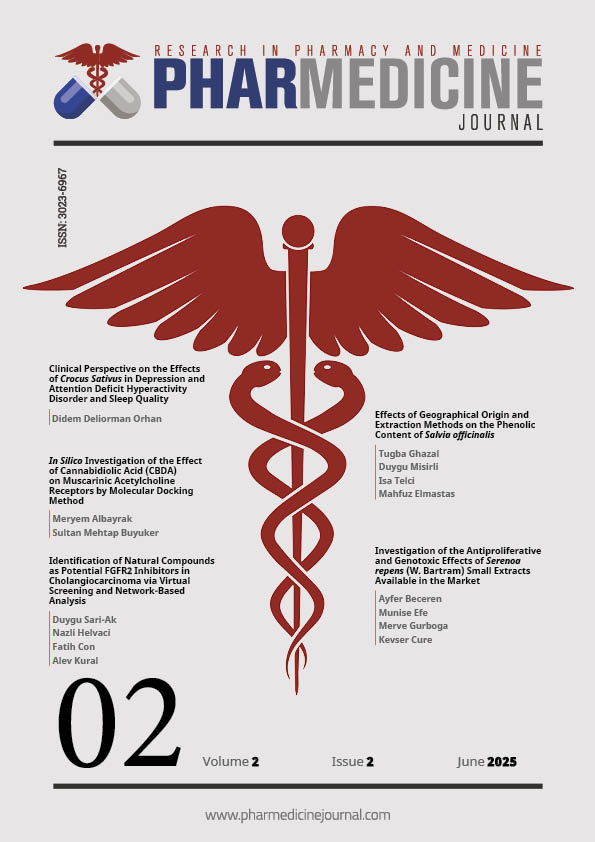In Silico Investigation of the Effect of Cannabidiolic Acid (CBDA) on Muscarinic Acetylcholine Receptors by Molecular Docking Method
DOI:
https://doi.org/10.62482/pmj.22Keywords:
Antiemetic, Cannabis sativa, in-silico, cannabidiolic acid (CBDA), molecular dockingAbstract
Introduction: Cannabis sativa contains phytocannabinoids with therapeutic potential for various diseases. Cannabidiolic acid (CBDA), such as phytocannabinoid, has demonstrated antiemetic effects. Postoperative nausea and vomiting are common complications often mediated by muscarinic acetylcholine receptors (mAChRs) in the vomiting center of the brain. This study aimed to investigate the antiemetic effects of CBDA on mAChRs using in silico methods.
Methods: The molecular structure of CBDA was obtained from the PubChem database. Molecular docking simulations with mAChRs were performed using the AutoDock Vina program. Docking results were visualized and analyzed with the Discovery Studio Visualizer software. N – [ methyl – 3 H]scopolamine (NMS), a known muscarinic receptor antagonist, was used as a reference drug for comparison.
Results: CBDA demonstrated strong binding affinity with mAChRs, particularly M1 and M3, through significant hydrogen and hydrophobic interactions. Compared to the reference drug NMS, CBDA exhibited significant binding affinity to the receptors, suggesting possible biological activities.
Conclusions: CBDA demonstrated comparable binding affinities to NMS, indicating its potential as a candidate for further antiemetic research. CBDA demonstrated comparable binding affinities to NMS, suggesting that it may have potential for antiemetic applications. However, further studies are needed to clarify its mechanism of action and clinical relevance. Also, its binding profile suggests potential for antiemetic applications, pending functional confirmation. Further in vitro and in vivo studies are required to validate these findings.
References
Hall J, Driscoll P. Nausea, vomiting and fever. Emerg Med J. 2005;22(3):200-204. https://doi.org/10.1136/emj.2004.022483
Grahame-Smith DG. The multiple causes of vomiting: Is there a common mechanism? In: Davis CJ, Lake-Bakaar GV, Grahame-Smith DG, editors. Nausea and Vomiting: Mechanisms and Treatment. Berlin: Springer-Verlag; 1986. p. 1–8. https://doi.org/10.1007/978-3-642-70479-6_1
Shankar A, Roy S, Malik A, Julka PK, Rath GK. Prevention of chemotherapy-induced nausea and vomiting in cancer patients. Asian Pac J Cancer Prev. 2015;16(15):6207-6213. https://doi.org/10.7314/apjcp.2015.16.15.6207
Iqbal IM, Spencer R. Postoperative nausea and vomiting. Anaesth Intensive Care Med. 2012;13(12):613–616. https://doi.org/10.1016/j.mpaic.2012.09.012
Becker DE. Nausea, vomiting, and hiccups: A review of mechanisms and treatment. Anesth Prog. 2010;57(4):150-157. https://doi.org/10.2344/0003-3006-57.4.150
Lang IM. Digestive tract motor correlates of vomiting and nausea. Can J Physiol Pharmacol. 1990;68(2):242-253. https://doi.org/10.1139/y90-038
Ahmed S, Hasan MM, Ahmed SW. Natural antiemetics: An overview. Pak J Pharm Sci. 2014;27(5 Suppl):1583-1598.
Parker LA, Rock EM, Limebeer CL. Regulation of nausea and vomiting by cannabinoids. Br J Pharmacol. 2011;163(7):1411- 1422. https://doi.org/10.1111/j.1476-5381.2010.01176.x
Sharkey KA, Wiley JL. Regulation of nausea and vomiting by cannabinoids and the endocannabinoid system. Eur J Pharmacol. 2013;722:134-146. https://doi.org/10.1016/j.ejphar.2013.09.068
Izzo AA, Sharkey KA. Cannabinoids and the gut: New developments and emerging concepts. Pharmacol Ther. 2010;126(1):21-38. https://doi.org/10.1016/j.pharmthera.2009.12.005
Tramèr MR, Carroll D, Campbell FA, Reynolds DJ, Moore RA, McQuay HJ. Cannabinoids for control of chemotherapy- induced nausea and vomiting: Quantitative systematic review. BMJ. 2001;323(7303):16-21. https://doi.org/10.1136/bmj.323.7303.16
Baron EP, Lucas P, Eades J, Hogue O. Patterns of medicinal cannabis use, strain analysis, and substitution effect among patients with migraine, headache, arthritis, and chronic pain in a medicinal cannabis cohort. J Headache Pain. 2018;19(1):37. https://doi.org/10.1186/s10194.018.0862-2
Lane JR, Kobilka BK. The muscarinic acetylcholine receptors: A review of receptor structure and pharmacology. Curr Opin Pharmacol. 2012;12(2):182-189. https://doi.org/10.1007/978-3-540-38918-7_6209
Caulfield MP, Birdsall NJM. Muscarinic receptors. In: Hardman JG, Limbird LE, editors. The Pharmacological Basis of Therapeutics. 9th ed. New York: McGraw-Hill; 1996. p. 241-268.
Pedigo NW Jr, Brizzee KR. Muscarinic cholinergic receptors in area postrema and brainstem areas regulating emesis. Brain Res Bull. 1985;14(2):169-177. https://doi.org/10.1016/0361-9230(85)90076-0
Kruse AC, Ring AM, Manglik A, Hu J, Hu K, Eitel K, Hübner H, Pardon E, Valant C, Sexton PM, Christopoulos A, Felder CC, Gmeiner P, Steyaert J, Weis WI, Garcia KC, Wess J, Kobilka BK. Activation and allosteric modulation of a muscarinic acetylcholine receptor. Nature. 2013;504(7478):101-106. https://doi.org/10.1038/nature12735
Paul A, Anandabaskar N, Mathaiyan J, Raj GM. Introduction to Basics of Pharmacology and Toxicology: Volume 2: Essentials of Systemic Pharmacology: From Principles to Practice. Singapore: Springer; 2021.
Albayrak M. Investigation of the antiemetic effects of cannabidiolic acid, the phytocannabinoid of Cannabis sativa plant, by in silico methods [Master’s thesis]. Istanbul (Turkey):Üsküdar University, Institute of Science, Department of Biotechnology; 2025. Thesis No: 811757.
Downloads
Published
How to Cite
Issue
Section
License
Copyright (c) 2025 Meryem Albayrak, Sultan Mehtap Büyüker

This work is licensed under a Creative Commons Attribution 4.0 International License.



